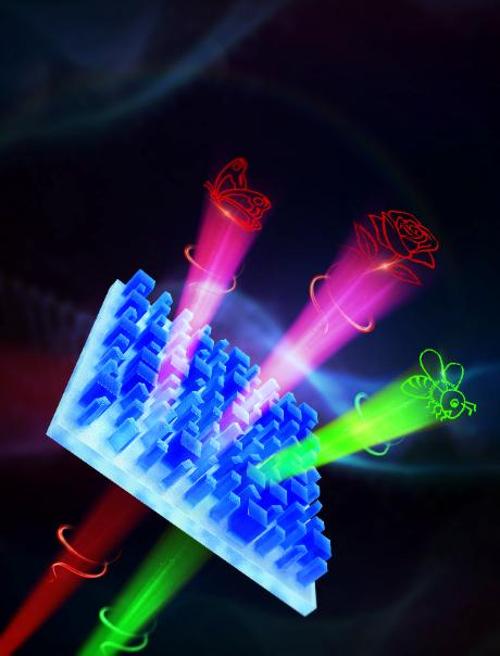Metasurfaces has provided a brand new nano-platform for controlling wavefront and intergrating traditional optical device. Metasurfaces have successfully applied in miniaturised optics, including wavefront shaping, asymmetric transmission, holographic displays, optical encryption, nonlinear optics, optical cloaking and so on. Especially, metasurface holography assisted by smart algorithms can conquer the challenges to realize large field of view, target-only diffraction orders and enhancement of information capacity.
In traditional metasurface holography, phase-only studies occupy mainstream applications. Usually, the amplitude distributions are uniform in phase-only meta-holograms. However, phase only metasurface holography has ignored another important modulation freedom. Because amplitude can also generate a hologram and reconstruct a target image through optimized nano-antennas array, called as amplitude holography. Amplitude holography can be realized by binary or discrete multi-order modulation.
As a typical binary amplitude modulation example, photon sieves could be applied effectively to achieve beam shaping, vortex beam and so on. However, since photon sieves usually compose of circular holes, the polarization sensitive property is lost. Nevertheless, hybrid dielectric amplitude filters and anisotropic nano-antennas can break the limitation of amplitude-only or phase-only modulation, leading to collaborative amplitude-phase tailoring within one single metasurface.
Recently, the research group led by Professor Huang Lingling from the Beijing Engineering Research Center of Mixed Reality and Advanced Display, School of Optoelectronics, Beijing Institute of Technology propose and experimentally demonstrate triple amplitude-phase holographic encryption strategy which integrates two binary amplitude holograms and one PB phase hologram assisted by quantitatively correlation. The research results are published in Photonics Research, Volume 10, No. 3, 2022 (Hongqiang Zhou, Xin Li, Zhentao Xu, Xiaowei Li, Guangzhou Geng, Junjie Li, Yongtian Wang, Lingling Huang. Correlated triple hybrid amplitude and phase holographic encryption based on a metasurface[J]. Photonics Research, 2022, 10(3): 03000678).
To fully utilize the space-bandwidth product of metasurface, we obtain rigorous relation in mathematics between the two binary amplitude hologram with A1⊃B1, and for the phase hologram we have the relationship A1⊃C. Actually, we achieve A1=B1∪C for the three holograms. Intriguingly, we develop a Correlated Gerchberg-Saxton (CGS) algorithm, by optimizing the "static" and "dynamic" nano-antennas functioning as spectral filter as well as phase contributor to fulfil the above scheme.
Three overlapping regions containing those switchable "dynamic" pixels are built on the metasurface. For the "static" pixels, we choose two kinds of isotropic square nanofins as amplitude "0" and "1" at both working wavelengths. While another kind of anisotropic rectangular nanofins are picked as optical amplitude switch buttons ("dynamic" pixel) based on wavelength selectivity. Simultaneously, those anisotropic antennas can function as phase contributors to reconstruct phase holography in cross-polarization channel. Hence quantitatively correlate triple holograms are formed by controlling wavelength and polarization combination.
Different from the traditional metal photon sieve structure, we provide a method that uses all-dielectric structure to achieve light transmission and block. We set two kinds of "static" pixels for (0, 0) and (1, 1) combination at two working wavelengths (λ1, λ2) in the same polarization. And we set another kind of "dynamic" pixels for (0, 1), that is, transparent at λ2 but opaque at λ1. While another degree of phase can be added for such "dynamic" pixels since one can apply the PB phase principle with anisotropic structures in cross-polarization channel.
They experimentally verified this scheme by generating two different amplitude holographic images (bees and butterflies) in the visible and near-infrared wavelength range in the co-polarization channel (LCP-LCP, λ1=510nm, λ2=720nm). And a phase hologram with blooming tangerine peony can be reconstructed in cross-polarization (LCP-RCP, λ2=720nm). Another sample with the reconstructed images (swan, hummingbird, and auspicious cloud) showes good holographic reconstruction quality as well (Fig.2).
Such metasurface can achieve amplitude and phase holography without sacrificing the space-bandwidth product. The experimental results successfully meet theoretical expectations. With the help of the selectivity of wavelength and polarization, we can dynamically switch on and off the holography. Furthermore, with elaborate design, the developed algorithm can be extended to realize the dynamic hybrid amplitude-phase holography within one device by integrating active materials. It enables high-capacity, high-speed holographic encryption, optical communication and optical manipulation in the case of incident structured light and polarization changes.

Figure.1 Schematic illustration of a hybrid quantitative correlation amplitude and phase holographic display based on an all-dielectric metasurface. Based on the wavelength and polarization selectivity of nanoantennas, the correlated holograms are encrypted by the combination of discrete wavelengths and same/opposite handedness circular polarization channels.

Fig. 2 (a) Scanning electron microscope (SEM) images with top view and 45° tilt view, scale bar: 4 μm. (b-c) Simulations and experimental results of triple amplitude phase holography using different wavelength and polarization combinations.


